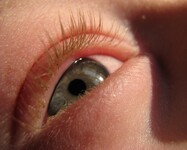 Anyone else dealing with horrible allergies right now? Did you know that allergies are not just a problem in the spring and summer seasons? Many people suffer from allergies during the fall as well, some even have allergies all year long! Ocular allergies, also known as allergic conjunctivitis, occur when an irritant or allergen hits the surface of the eye causing an inflammatory response which results in red, itchy, watery eyes. It is not uncommon for the eye lids to also become red, itchy and swollen. Many people with ocular allergies also have nasal allergies and will develop a stuffy, or runny nose, and sneezing. Most people with seasonal allergies are used to taking over-the-counter allergy medicine in pill form or nasals sprays, but did you know, when someone is experiencing allergic conjunctivitis, it is best to use an allergy eye drop to target the ocular symptoms directly. Symptoms: Redness in the white part of they or on eyelids Watery eyes Itching Burning Swelling Causes: Ocular allergies occur when an allergen hits the surface of the eye creating an immune response. The eye tries to fight off the allergen by activating cells in the eye called mast cells to release histamine. Once the histamine is released your eyes develop the typical allergy symptoms of redness, itching, and watering. Treatments: Most of the treatments are aimed at blocking the histamine from binding to receptors in the eye, these drugs are known as anti-histamines. Some of the newer medications block histamine binding and also work to stabilize the mast cells in order for them to stop releasing histamine, these are known as mast cell stabilizers.
0 Comments
COVID-19 Update
Here is what we are doing to keep you safe: To keep our patients and our staff safe and healthy, beginning May 1st, we implemented the following procedures in our office: Limited Appointment Scheduling – In order to ensure we are able to properly disinfect and adhere to Social Distancing Guidelines set forth by our local authority, there will be limited appointment availability. Urgent and emergency patients will be prioritized. Fever Free Environment – Temperatures will be taken upon entering the clinic of all patients, staff, and doctors. Anyone with 99.5 degrees or higher will be asked to reschedule. Anyone who is taking a fever-reducing medication such as ibuprofen or acetaminophen will be asked to reschedule once the medication is clear from their system so we can be sure of an accurate temperature reading. Pre-Screening Questionnaire – We will continue to ask any patient with upper respiratory symptoms to reschedule their appointment until they have been asymptomatic for 2 weeks or have a negative COVID test. Face Covering – We are still requiring everyone entering our clinics to wear some type of facial covering such as a homemade mask, scarf, bandana, or handkerchief. Advances in Vision staff will be required to wear a mask. Wash hands and sanitize – Upon entering, everyone will be asked to sanitize their hands. Social Distancing – We are limiting the number of patients in our office and are asking, when possible, only the patient enters our clinics for their visit. Please ask anyone accompanying you to stay in their car. We can call them if we need their assistance. Physical Changes – We have installed sneeze guards at our front desk and at the slit-lamp in the exam room. We will also be opening all doors for you so that you do not have to touch anything. Disinfecting eyewear – Each frame that is tried on will be thoroughly disinfected prior to be returned to the display shelves. Paper free – We are emailing the intake forms ahead of time so you do not have to fill out paperwork in the office. Payment methods – While we will still accept cash and credit cards, we are offering Apple pay, Google pay and Samsung pay for those that would prefer to be touchless. Thank you for your support and understanding during these unprecedented times. Please stay safe and healthy. Video Games and Vision: How Healthy Eyes Can Help Beat Your High Score
Dr. Michele Quintero and the American Optometric Association Share How to Gain a Competitive Advantage by Giving Your Eyes a Break Spring break is in full swing and we know a high percentage of kids will be spending a lot of time playing video games. With the popularity of video games and competitive gaming on the rise, players are always looking for an edge. Whether battling a computer opponent or Player Two, one secret weapon can help land the high score: the American Optometric Association’s (AOA) 20-20-20 rule, which encourages gamers to give their eyes a 20-second rest every 20 minutes. The AOA’s 2017 American Eye-Q® survey revealed that 41 percent of Americans spend more than four hours a week playing video games. Staring at digital devices can lead to digital eye strain, sleep problems, blurred vision, headaches and neck and shoulder pain, among other things. Yet, only 21 percent of Eye-Q® respondents have talked to an eye health professional about the amount of time spent playing video games. In addition to encouraging players to discuss game usage with an optometrist, Dr. Quintero is sharing some insider tips on how to help ease eye discomfort during this year’s Save Your Vision Month in March.
“Those who spend excessive time in front of screens may experience physical discomfort, like the nearly one-third of gamers who reported headaches or blurry vision in our survey,” said Dr. Michele Quintero, OD, “Save Your Vision Month is the perfect time to prioritize eye health by practicing the 20-20-20 rule.” If you think you are experiencing any of the symptoms listed below due to prolonged exposure to digital devices, schedule an appointment with Dr. Quintero. For additional information on how eye health may be impacted while playing video games, please visit www.aoa.org. Symptoms:
DR. QUINTERO AWARDED 2020 OPTOMETRIST OF THE YEAR Cypress-area Optometrist Dr. Sam Quintero Recognized as Optometrist of the Year by the Texas Optometric Association Houston, TX (January 31, 2020) – Cypress-area optometrist Dr. Sam Quintero was recognized as Optometrist of the Year by the Texas Optometric Association (TOA). The award ceremony took place Saturday, February 1 during the annual TOA Summit in Austin, TX. The Optometrist of the Year Award is presented to a TOA member optometrist who has rendered outstanding cumulative service to the association and the profession. “I’ve been practicing optometry for more than 40 years, and I’ve seen a lot of positive changes in the industry that I know the TOA has helped implement,” said Dr. Quintero. “I’m grateful to have been able to be a part of that, and I’m humbled to have received this award.” Growing up, Dr. Quintero was the oldest of six siblings and the first in his family to attend college. He attended the University of Houston and was then accepted into the College of Optometry (UHCO). Following graduation from optometry school, he became a faculty member of UHCO in 1972 and has since dedicated his life to the profession. He is an exceptional role model for all optometrists, young and old. Over the course of his career he has given back to optometry and UHCO not only through teaching and mentoring students but also through his service and dedication to the profession. He currently serves on several task forces for the Association of Schools and Colleges of Optometry (ASCO). “I always knew I wanted to follow in my dad’s footsteps,” said Dr. Michele Quintero. “For as long as I can remember he has dedicated his time to serve the profession and has so much passion and love for optometry. I hope he knows that he has instilled these qualities in me and his students. I’m so proud of my dad for all he has accomplished throughout his career and I couldn’t ask for a better business partner!” In addition to Optometrist of the Year, he has been recognized for his contributions to education by the Texas Optometric Association having received the Educator of the Year Award in 2005. He was also recognized for his contributions to the American Academy of Optometry, receiving the Eminent Service Award in 1998. Dr. Sam Quintero continues his role as adjunct associate professor at the University of Houston College of Optometry and is in private practice with his daughter, Dr. Michele Quintero, at Lakeshore Eye Care in Cypress, TX. 👀Food for your eyes👀
Carotenoids are antioxidants and some are converted by the body into vitamin A. They may help protect your eyes from the damaging effects of blue light and lower your risk of macular degeneration. Examples of carotenoids include carrots, sweet potato, kale, mango, tomato, oranges, papaya, pumpkin, and apricots🍅🥕🌽🍊🥭🍠 Lutein and Zeaxanthin are specific carotenoids that are depositors in high quantities in the retina. They help filter harmful high-energy blue wavelengths of light and help protect band maintain healthy cells in the eyes. They are not naturally made in the body so we have to get them through our food or supplements. They are found in green leafy vegetables like kale, spinach, broccoli, Swiss chard, collards, also found in peas, pumpkin, corn, Brussels sprouts, avocados.🥑🥦🌽🥬🥗 Age Related Macular Degeneration
What is it: Age Related Macular Degeneration (AMD) is a disease that affects the macula, the part of the eye responsible for your central vision. Damage to this area results in a loss of vision in the center of your field of view making it difficult to read, drive, and recognize faces. AMD usually affects people over the age of 50, and affects women more often than men. Causes and Risk factors: UV light exposure Smoking Poor diet Advancing age Hereditary Signs/Symptoms: Early Stages: minimal to no symptoms Moderate stages: distortion, blurring, or missing areas of the central vision; faces become blurred, reading becomes difficult as letters or words appear missing Late Stage: significant vision loss in the central area How is it detected: The best way to detect this disease is by having your eyes examined yearly (or more frequently if directed by your doctor). During your exam your doctor will examine the retina (the back layer of your eye) to look for any changes or deterioration of the macula. She may order additional tests such as retinal photos or an OCT which shows a cross section of the different retinal layers. How is treated: There are two forms of AMD – a dry and a wet form. The dry form is more common, making up about 90% of all AMD cases and causes less severe vision loss, however currently there is no specific treatment for the dry form. The wet form accounts for about 10% of cases, but causes about 90% of the severe vision loss associated with AMD. The wet form is treated with anti-vegf (medication that blocks vascular endothelial growth factor). Both forms have been shown to benefit from eye vitamins, specifically the AREDS 2 formula. Sun protection is very important since UV light exposure is known to cause/worsen the condition. It is recommended to always wear good UVA/UVB blocking sunglasses and hats to keep the sun’s rays from entering above the sunglasses. It is important to see your eye doctor regularly and inform the doctor of any changes to your vision. |
AuthorAdvances in Vision is your new source for state-of-the-art vision and eye health testing, top-quality eyewear and contact lenses. Our goal is to provide you with the highest quality of eye care. ArchivesCategories |
Location |
|


 RSS Feed
RSS Feed